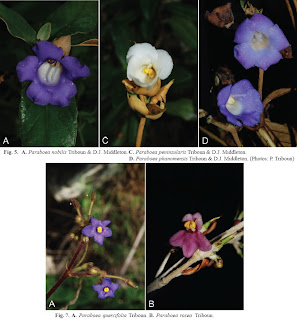Abstract
Twenty new species of Paraboea are described from Thailand: Paraboea arachnoidea Triboun, Paraboea axillaris Triboun, Paraboea bhumiboliana Triboun & Chuchan, Paraboea doitungensis Triboun & D.J.Middleton, Paraboea eburnea Triboun, Paraboea insularis Triboun, Paraboea lavandulodora Triboun, Paraboea monticola Triboun & D.J.Middleton, Paraboea nana Triboun & Dongkumfu, Paraboea nobilis Triboun & D.J.Middleton, Paraboea peninsularis Triboun & D.J.Middleton, Paraboea phanomensis Triboun & D.J.Middleton, Paraboea quercifolia Triboun, Paraboea rosea Triboun, Paraboea sangwaniae Triboun, Paraboea siamensis Triboun, Paraboea takensis Triboun, Paraboea tenuicalyx Triboun, Paraboea vachareea Triboun & Sonsupab and Paraboea xylocaulis Triboun. Full descriptions and conservation assessments are provided for all taxa.
Paraboea sangwaniae Triboun | CR | นครินทรา | Chiang Rai, Doi Tung
Paraboea doitungensis Triboun & D.J.Middleton | EN | ชาฤาษีดอยตุง | Chiang Rai
Paraboea bhumiboliana Triboun & Chuchan | ภูมิพลินทร์ | Lamphun, Li
Paraboea nana Triboun & Dongkumfu | LC | ชาฤาษีน้อย | Lamphun, Li, Mae Ping NP
Paraboea nana Triboun & Dongkumfu | LC | ชาฤาษีน้อย | Lamphun, Li, Mae Ping NP
Paraboea lavandulodora Triboun | NT | ชาฤาษีใบหอม | Bung Kan, Phu Tok
Paraboea quercifolia Triboun | CR | ชาฤาษีใบก่อ | Lopburi
Paraboea axillaris Triboun | CR | ข้าวตอกฤาษี | Tak, Umphang
Paraboea siamensis Triboun | CR | ศรีสยาม | Tak, Um Phang
Paraboea siamensis Triboun | CR | ศรีสยาม | Tak, Um Phang
Paraboea takensis Triboun | CR | ข้าวตอกใหญ่ | Tak, Um Phang
Paraboea vachareea Triboun & Sonsupab | CR | วัชรีพรรณ | Tak, Um Phang
Paraboea tenuicalyx Triboun | VU | ข้าวตอกพระนเรศ | Kanchanaburi, Tung Yai Naresuan WS
Paraboea eburnea Triboun | CR | ชาฤาษีพระขยางค์ | Ranong, Kraburi
Paraboea arachnoidea Triboun | EN | ชาฤาษีใยแมงมุม | Krabi, Mu Koh Lanta
Paraboea rosea Triboun | VU | ดาวประดับผา | Krabi, Mu Koh Lanta
Paraboea insularis Triboun | VU | สุดสาคร | Phanggna-Krabi bay
Paraboea peninsularis Triboun & D.J.Middleton | EN | สินสมุทร | Krabi: Muang Krabi
Paraboea xylocaulis Triboun | CR | ชาหนุมาน | Krabi-Phangnga bay
Paraboea monticola Triboun & D.J.Middleton | VU | ชาพ่อตาฤาษี | Phangnga and Surat Thani
Paraboea nobilis Triboun & D.J.Middleton | EN | ศรีรัชประภา | Surat Thani, Ban Thakhun, Khao Sok NP
Paraboea phanomensis Triboun & D.J.Middleton | LC | ศรีสุราษฎร์ | Surat Thani, Khlong Phanom NP
_______________________
Paraboea arachnoidea Triboun | EN | ชาฤาษีใยแมงมุม | Krabi, Mu Koh Lanta
Paraboea axillaris Triboun | CR | ข้าวตอกฤาษี | Tak, Umphang
Paraboea axillaris Triboun | CR | ข้าวตอกฤาษี | Tak, Umphang
Paraboea bhumiboliana Triboun & Chuchan | ภูมิพลินทร์ | Lamphun, Li
Paraboea doitungensis Triboun & D.J.Middleton | EN | ชาฤาษีดอยตุง | Chiang Rai
Paraboea eburnea Triboun | CR | ชาฤาษีพระขยางค์ | Ranong, Kraburi
Paraboea eburnea Triboun | CR | ชาฤาษีพระขยางค์ | Ranong, Kraburi
Paraboea insularis Triboun | VU | สุดสาคร | Phang-gna-Krabi bay
Paraboea lavandulodora Triboun | NT | ชาฤาษีใบหอม | Bung Kan, Phu Tok
Paraboea lavandulodora Triboun | NT | ชาฤาษีใบหอม | Bung Kan, Phu Tok
Paraboea monticola Triboun & D.J.Middleton | VU | ชาพ่อตาฤาษี | Phangnga and Surat Thani
Paraboea nana Triboun & Dongkumfu | LC | ชาฤาษีน้อย | Lamphun, Li, Mae Ping NP
Paraboea nobilis Triboun & D.J.Middleton | EN | ศรีรัชประภา | Surat Thani, Ban Thakhun, Khao Sok NP
Paraboea peninsularis Triboun & D.J.Middleton | EN | สินสมุทร | Krabi: Muang Krabi
Paraboea phanomensis Triboun & D.J.Middleton | LC | ศรีสุราษฎร์ | Surat Thani, Khlong Phanom NP
Paraboea quercifolia Triboun | CR | ชาฤาษีใบก่อ | Lopburi
Paraboea rosea Triboun | VU | ดาวประดับผา | Krabi, Mu Koh Lanta
Paraboea sangwaniae Triboun | CR | นครินทรา | Chiang Rai, Doi Tung
Paraboea siamensis Triboun | CR | ศรีสยาม | Tak, Um Phang
Paraboea takensis Triboun | CR | ข้าวตอกใหญ่ | Tak, Um Phang
Paraboea tenuicalyx Triboun | VU | ข้าวตอกพระนเรศ | Kanchanaburi, Tung Yai Naresuan WS
Paraboea vachareea Triboun & Sonsupab | CR | วัชรีพรรณ | Tak, Um Phang
Paraboea xylocaulis Triboun | CR | ชาหนุมาน | Krabi-Phangnga bay
Pramote Triboun and David J. Middleton. 2012. Twenty new species of Paraboea (Gesneriaceae) from Thailand. Gardens’ Bulletin Singapore. 64(2): 333–370.
https://www.sbg.org.sg/images/4_4_Research_Gardens_Bulletin/4_4_64_2_pdf_Vol_64_Part2_2012/4.4.64.2.05_y2012_V64P2_GBS_pg.333.pdf
https://www.sbg.org.sg/images/4_4_Research_Gardens_Bulletin/4_4_64_2_pdf_Vol_64_Part2_2012/4.4.64.2.05_y2012_V64P2_GBS_pg.333.pdf
ภูมิพลินทร์ Paraboea bhumiboliana Triboun & Chuchan วงศ์ Gesneriaceae
Trisepalum bhumibolianum
Trisepalum bhumibolianum

















































